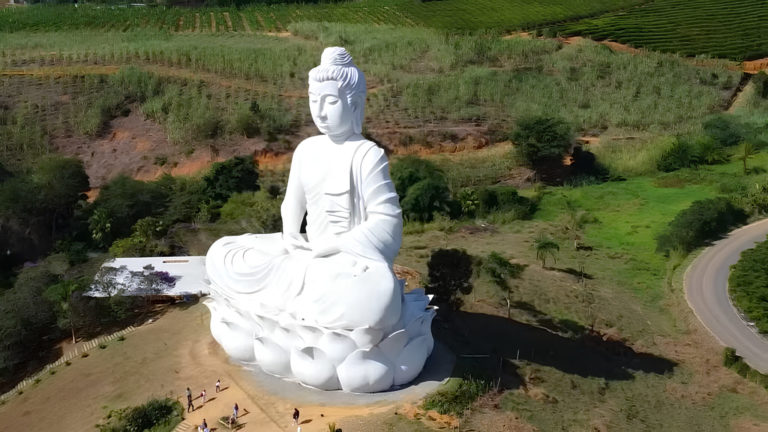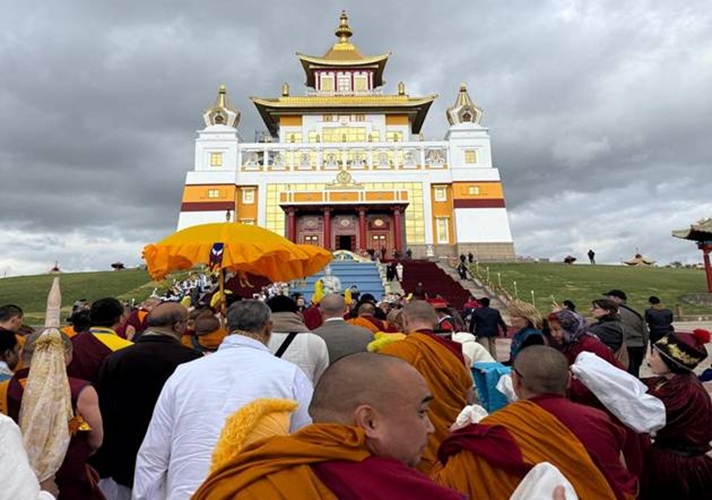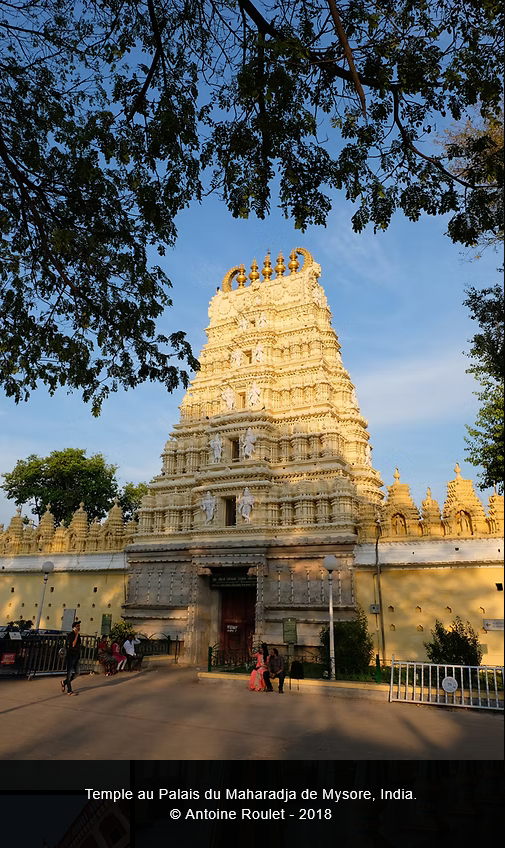Sankisa Basantpur, Farrukhabad: After a four-hour drive from Lucknow, six-hour from Delhi — the last leg of which takes one though stretches barely as wide as one’s car, crisscrossing villages with population of 500 or less, lush green vegetation on both sides, old trees gnarled into overhead arches — one arrives at Sankisa Basantpur in Uttar Pradesh’s Farrukhabad district.
The tiny village, with a population of around 2,000, shares its border with two other districts – Etah and Mainpuri – the nearest cities, Etah and Farrukhabad, being at least 40 kilometres away. There is nothing striking about the place except a mound that has three flights of brick stairs that is by most accounts around 2600-year-old. Among Buddhists across the world, it is venerated as the “staircase to heaven”.
The Buddha’s Descent
Sankasya (also Sankissa, Sankassa) is one of the ‘Eight Great Places’ (Ashtamahasthan, in the Pali canons) of the Buddhist pilgrimage. According to Buddhist literature, it was here that the Buddha performed the ‘miracle of descending from the heavens accompanied by Indra and Brahma’. The Buddhist text says that in his 41st year, the Buddha went up from Shravasti to the Trayastrimsa (also called Tushita) heaven and passed the rainy season retreat teaching Abhidharma to his mother Mayadevi, who had died seven days after his birth. Three months later, at the time of his descent from paradise, kings and devotees from the eight kingdoms gathered at Sankisa. According to Buddhist literature, a flight of gold stairs appeared, which the Buddha climbed down accompanied by Brahma on the right and by Indra holding a jewelled umbrella on the left.
The relief of Buddha’s descent from heaven has been found at Sanchi, Bharhut, Sankisa and a few other places.
In 249 BC, King Ashoka visited Sankisa as part of his pilgrimage to all eight places of the Buddha’s life. He constructed a stupa and erected one of his pillars, 60 feet high according to Chinese pilgrim Fa Hian who visited Sankisa in the 5th century.
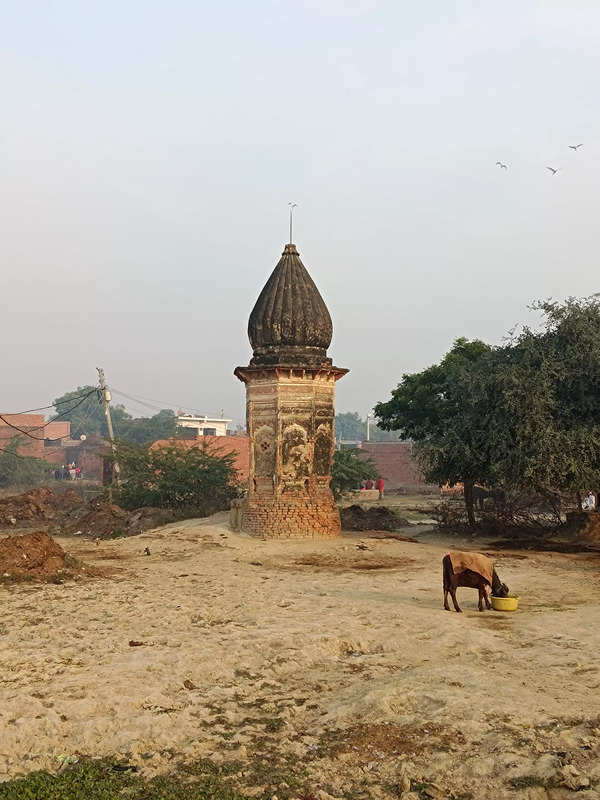
Pilgrims From China
The Chinese travellers – Fa Hian and Hwen Thsang, 7th century — mentioned Sankisa as ‘Song-kia-she or Kia-pi-tha’ in their accounts. Samuel Beal in his translated account of Fa Hian – Travels of Fah-Hian and Sung-Yun, Buddhist pilgrims, from China to India (400 A.D. and 518 A.D.) – also relates an interesting tale about Sankisa. “As per legend, Bodhisattva Maitreya was born here in Sankassa as a millionaire named Siriwardhana at the period of the Buddha Gautama, and on this exact day, the day the Buddha descended from heaven Tavatimsa, Siriwardhana arrived to this area and was admitted to the Buddha’s dispensation here,” Beal writes. Not much is known about Siriwardhana but the story confirms the sanctity of Sankisa even during the Buddha’s lifetime.
Hwen Thsang saw a 70-foot high staircase at the spot where the Buddha had descended from heaven. He describes the “three holy flights of steps as being in a line from north to south and facing east”. On the top of the stairs was a temple with a stone image of the Buddha that according to Fa Hian was 16 cubit (16 ft) tall. Close to the stairs was a 70 ft high Ashokan pillar, he wrote.
Both Hwen Thsang and Fa Hien saw three ladders in the decaying shrine, which had been made of bricks and stone by the ancients to mark the Buddha’s descent, but the ladders were practically submerged in the ground. (James B Pratt, The Pilgrimage of Buddhism, 1928)
Both the pilgrims saw the pillar, which is now all gone except its famous elephant capital, still standing. While Fa Hian saw Sankisa full of shramnas (Buddhist monks), Hwen Thsang saw a stronger presence of Brahmans and their temple in the area.
Sankisa’s Rediscovery
In 1842, Alexander Cunningham identified the village of Sankisa Basantpur with the place Sankasya mentioned by Fa Hian. “In March 1876, I went there (to Sankisa) for the express purpose of searching for the remains of the great Asoka pillar, of which only the elephant capital now exists above ground,” Cunningham wrote (ASI, Vol XI). The archaeologist mentioned that the site was referred to as the mound of Bisari Devi by then. He concluded that the three flights of holy steps, as mentioned by the Chinese pilgrims, must have certainly been on this mound.
He dug up the remains of the base of the Ashokan pillar based on the calculations of Fa Hian and found some important terracotta figures, coin and soapstone artefacts.
The site has yielded the painted grey ware culture (middle and late Vedic period) and northern black polished ware (Mahajanapadas and Mauryan eras) and its associated red wares (IAR 1955-6). Coins of copper, also punch-marked, and an inscription with sculpture representing a ladder with the figure of Bhikshuni Utpala, whose tale is related by both Fa Hian and Hwen Thsang, at the base and a plaque of soapstone were some of the important finds at the site.
Based on the depth of the elephant capital and accumulation of soil in over 2000 years, Cunnigham calculated that an earthquake sometime in 750 AD must have razed the pillar and the great monastery, Sangharama, at Sankisa.
“Judging by the thickness of the enclosing wall of the monastery, I cannot help thinking that it must have been thrown down by an earthquake; and as it is lying in the same direction as the prostrate pillar, I suspect that both may have fallen at the same time,” he wrote (Tours in the Gangetic Provinces from Badaon to Bihar, 1875-76 & 1877-78).
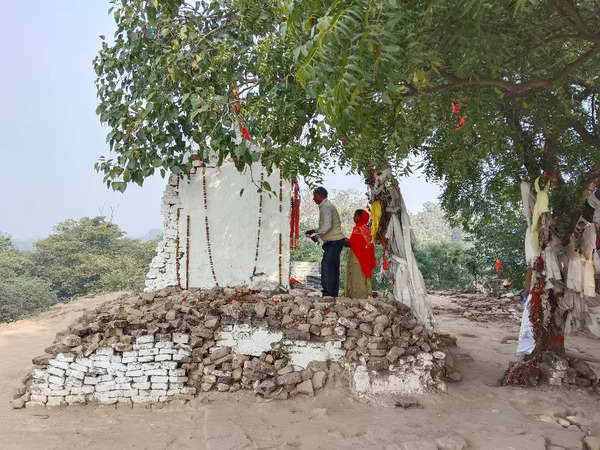
The Ramayana Connection
Sankisa has also been identified with Sankasya Nagar of Valmiki’s Ramayana. It was ruled by Kushadhvaja, the younger brother of King Janaka of Mithila. Kushadhvaja’s two daughters, Mandavi and Shrutakirti, were married to Lord Ram’s younger brothers, Bharata and Shatrughna, respectively.
According to the Ramayana, Sudhanva, supposedly an evil king of Sankasya Nagar, once sought the hand of Sita from King Janaka. In a war that ensued, Janaka defeated and perhaps killed Sudhanva. He bestowed the kingdom of Sankasya to his brother Kushadhwaja.
The Dispute
Sankisa has been a bone of contention between local Hindus and Budddhist monks for a long time. There is also a case being heard in the Allahabad high court.
When this writer visited the site in December 2023, a group of Buddhist monks sat in meditation just below the staircase leading to the mound. The seniormost of them, Bikshu Buddh Ratna, said he had heard about Sankisa being a disputed site most of his life. On the top of the mound, a few locals visited a small brick temple dedicated to Bisari Devi and prayed in silence. To the left of the shrine were the Buddha’s footprints in stone where pilgrims had tied white prayer flags to a tree. To the shrine’s right is a small temple dedicated to Lord Hanuman. A few broken pieces of ancient artefacts are also worshipped by the locals.
The dispute for the site is not recent for sure.
In the 5th century, Fa Hian wrote, “Some heretical doctors had a contention with the Shamans (a term used for Buddhist monks) respecting this (Sankisa) as a place of residence. The Shamans agreed to any condition for settling the question that might be considered reasonable. On which, they all bound themselves to this compact. If this place properly belongs to the Shamans, then there will be some supernatural proof given of it. Immediately on this, the lion on the top of the pillar uttered a roar. Witnessing this testimony, the unbelievers abashed, withdrew from the dispute and submitted.” (Beal)
These heretical doctors, or heterodox philosophers, were, according to M. Remusat (in Travels of Fa Hian in India), most probably ‘Brahmans’.
According to Cunnigham, the Buddhists kept possession of Sankisa up to Fa Hian’s time but had most probably lost hold over it by the time Hwen Thsang landed in India, who recorded that “there were no less than ten temples of the gods and numbers of heretics here, while there were only four monasteries with about one thousand monks” (M. Julien, Journal of the Royal Asiatic Society, Vol 17).
A Tale of Kayasthas
Cunningham has quoted a tradition that Sakisa was deserted between 1800 and 1900 years ago. He also wrote that in about 560 AD, a few decades before Hwen Thsang came here, the town was given by a Kayasth to a body of Brahmans (ASI, Vol 1, p279). The British archaeologist who first visited Sankisa in 1842 found that the village of Sankisa Basantpur was largely inhabited by Brahmins while Kayasthas lived in the neighbouring villages of Pakhna and Bihar (make note of the Pali names of the villages). He also mentioned that the majority of those Kayasthas were called Saksena (or Sanki-sena) and claimed to be descendants of a body of migrants from Sankisa. An interesting connect here is that many Kayasthas from Bareilly (ancient Kampilya, which is in the vicinity of Farrukhabad) are now called Bisaria (perhaps after the same Bisari Devi whose temple stands on the mound of Sankisa).
When this writer visited Sankisa and its neighbourhood in 2023, Sankisa was still largely inhabited by Brahmins while many Saxena Kayasthas lived in Pakhna village.
If you look closely at the accounts of visitors beginning Fa Hian (5th CE) till Cunnigham (1842), it seems like the part of the same continuing story of a dispute between Hindus and Buddhists for Sankisa and how a body of Kayasthas, who were basically keeper of land records, bequeathed the town to Brahmins somewhere during the rise of Gupta Empire.
The Present-Day Story
Continuity is mostly a chimera for historians. Sankisa is where it is achieved almost in totality. In at least 2600 years of its historical existence and a few centuries earlier as per religious scriptures, the place has not changed name and has been found by the visitors in more or less its present condition, except the wear and tear caused by the natural calamities and ravages of time.
The present village is nondescript but for the shrine. Its economy largely revolves around pilgrimage and agriculture.
Somewhere in the beginning of the 20th century, renowned Sri Lankan Buddhist monk Anagarika Dharmapala, who founded the Mahabodhi Society and shared the dais with Swami Vivekananda at the Parliament of World Religions in Chicago in 1893, came here on spiritual quest and set up a monastery. In 1957, Panditha Madabawita Wijesoma Thero (Sri Lanka) also came to Sankisa. Due to their efforts, many Buddhist countries like Myanmar, Cambodia and Japan, set up their monasteries here.
This writer met a young Cambodian monk, Sakina, at the country’s monastery in Sankisa. Sakina can barely speak either Hindi or English and spends most of his time in meditation. He has been here for six months and visits a Brahmin’s house in Sankisa village regularly to learn Hindi. He is a little excited about visiting Cambodia as his visa is about to expire but wants to come back again.

